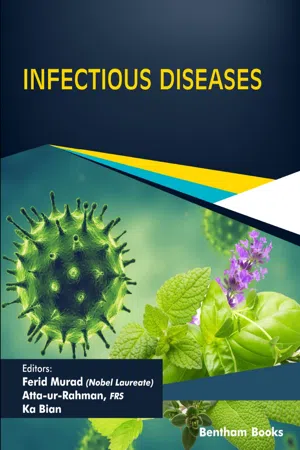
Infectious Diseases
- English
- ePUB (mobile friendly)
- Available on iOS & Android
Infectious Diseases
About this book
Herbal Medicine: Back to the Future compiles expert reviews on the application of herbal medicines (including Ayurveda, Chinese traditional medicines and alternative therapies) to treat different ailments. The book series demonstrates the use of sophisticated methods to understand traditional medicine, while providing readers a glimpse into the future of herbal medicine. This volume presents reviews of plant based therapies useful for treating different infectious diseases. The list of topics includes some niche reviews in this area including a review of the neem plant, the historical use of herbs in infectious disease therapy in Russia, and natural remedies from garlic, among other topics., The topics included in this volume are: - Improving anti-microbial activity of allicin and carvacrol through stabilized analogs and nanotechnology - Plant phenolics as an alternative source of antimicrobial compounds - Herbal medicine in Russia's history: the use of herbal medicine for infectious diseases in Russia's history - Azadirachta indica (neem) in various infectious diseases - Contribution of novel delivery systems in the development of phytotherapeutics This volume is essential reading for all researchers in the field of natural product chemistry and pharmacology. Medical professionals involved in internal medicine who seek to improve their knowledge about herbal medicine and alternative therapies for tropical and other infectious diseases will also benefit from the contents of the volume.
Frequently asked questions
- Essential is ideal for learners and professionals who enjoy exploring a wide range of subjects. Access the Essential Library with 800,000+ trusted titles and best-sellers across business, personal growth, and the humanities. Includes unlimited reading time and Standard Read Aloud voice.
- Complete: Perfect for advanced learners and researchers needing full, unrestricted access. Unlock 1.4M+ books across hundreds of subjects, including academic and specialized titles. The Complete Plan also includes advanced features like Premium Read Aloud and Research Assistant.
Please note we cannot support devices running on iOS 13 and Android 7 or earlier. Learn more about using the app.
Information
Plant Phenolics as an Alternative Source of Antimicrobial Compounds
Inamullah Hakeem Said1, *, Nikolai Kuhnert1, *
Abstract
* Corresponding authors Inamullah Hakeem Said & Nikolai Kuhnert: Department of life sciences and Chemistry, Jacobs University Bremen, 28759 Bremen, Germany; E-mails: [email protected] and n.kuhnert@ jacobs-university.de
INTRODUCTION
Table of contents
- BENTHAM SCIENCE PUBLISHERS LTD.
- PREFACE
- List of Contributors
- Improving Anti-Microbial Activity of Allicin and Carvacrol through Stabilized Analogs and Nanotechnology
- Plant Phenolics as an Alternative Source of Antimicrobial Compounds
- Herbal Medicine in Russia’s History: The Use of Herbal Medicine for Infectious Diseases in Russia’s History
- Azadirachta Indica (Neem) in Various Infectious Diseases
- Contribution of Novel Delivery Systems in the Development of Phytotherapeutics